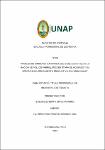| dc.contributor.advisor | Vásquez Macedo, Hernando | |
| dc.contributor.author | Ortiz Navarro, Eveling Estefita | |
| dc.date.accessioned | 2024-01-12T14:51:11Z | |
| dc.date.available | 2024-01-12T14:51:11Z | |
| dc.date.issued | 2023 | |
| dc.identifier.other | 636.0855 O74 2023 | |
| dc.identifier.uri | https://hdl.handle.net/20.500.12737/9690 | |
| dc.description.abstract | The present investigation was carried out in the facilities of the shed of Mr. Shankar Ríos Pinedo, district of Yurimaguas, Alto Amazonas province, Loreto region. The general objective was to determine the effect of canavalia (Canavalia ensiformis) flour levels on the productive performance of broiler chickens in the finishing stage. Parameters were evaluated: feed consumption, weight gain, feed conversion, carcass yield, economic merit and taste test in 256 broiler chickens-Cobb line. The Completely Random statistical design was used, with 4 treatments and 4 repetitions with a degree of confidence (P<0.05), these treatments were: T0: 0%, T1: 1%, T2: 2% and T3: 3%, level of canavalia flour respectively. The results: the food consumption was: 163.23 g, 168.92 g, 163.77 g and 162.10 g for the treatments T0, T1, T2 and T3 respectively, with no significant statistical difference in the treatments (P>0.05). Regarding the weight increase, there was no significant statistical difference (P>0.05) in the treatments with respect to the control with values of: T0: 80.09 g.; T1: 83.28 g.; T2: 82.32 g. and T3: 82.27 g. No significant statistical difference was found in feed conversion (P>0.05) and with final values of T0: 2.04; T1: 2.03, T2: 1.99 and T3: 1.97. A 0.78% mortality was recorded in the investigation. Regarding carcass yield, values of: T0: 74.13% were obtained; T1: 75.28%; T2: 74.53% and T3: 74.47. The greatest economic merit was achieved in T1 with S/ 2.67. The best meat preference at the time of tasting was: T1: 62.5% and T2: 37.5%. Concluding that, by including canavalia flour with levels of 1, 2 and 3%, it does not affect the productive performance of broiler chickens in the finishing stage. | en_US |
| dc.description.abstract | La presente investigación se realizó en las instalaciones del galpón del Sr. Shankar Ríos Pinedo, distrito de Yurimaguas, provincia Alto Amazonas, región Loreto. El objetivo general fue determinar el efecto de los niveles de harina de canavalia (Canavalia ensiformis) sobre el rendimiento productivo de los pollos parrilleros en la etapa de acabado. Se evaluó los parámetros: el consumo de alimento, el incremento de peso, la conversión alimenticia, el rendimiento de carcasa, el mérito económico y la prueba de degustación en 256 pollos parrilleros-línea Cobb. Se utilizó el diseño estadístico Completamente al Azar, con 4 tratamientos y 4 repeticiones con un grado de confianza (P<0.05), estos tratamientos fueron: T0: 0%, T1: 1%, T2: 2% y T3: 3%, de nivel de harina de canavalia respectivamente. Los resultados: el consumo de alimento fue: 163.23 g, 168.92 g, 163.77 g y 162.10 g para los tratamientos T0, T1, T2 y T3 respectivamente, no existiendo diferencia estadística significativa en los tratamientos (P>0.05). En cuanto al incremento de peso no existió diferencia estadística significativa (P>0.05) en los tratamientos con respecto al testigo con valores de: T0: 80.09 g.; T1: 83.28 g.; T2: 82.32 g. y T3: 82.27 g. En la conversión alimenticia no se encontró diferencia estadística significativa (P>0.05) y con valores finales de T0: 2.04; T1: 2.03, T2: 1.99 y T3: 1.97. Se registró 0.78% de mortandad en la investigación. Con respecto al rendimiento de carcasa se obtuvo valores de: T0:74.13%; T1:75.28%; T2:74.53% y T3:74.47. El mayor mérito económico se logró en el T1 con S/ 2.67. La mejor preferencia de carne al momento de la degustación fue: T1: 62.5% y T2:37.5%. Concluyendo que, al incluir harina de canavalia con niveles de 1, 2 y 3% no afecta el rendimiento productivo de los pollos parrilleros en la etapa de acabado. | es_PE |
| dc.format | application/pdf | es_PE |
| dc.language.iso | spa | es_PE |
| dc.publisher | Universidad Nacional de la Amazonía Peruana | es_PE |
| dc.rights | info:eu-repo/semantics/openAccess | * |
| dc.rights.uri | https://creativecommons.org/licenses/by/4.0/ | * |
| dc.subject | Piensos | es_PE |
| dc.subject | Harinas | es_PE |
| dc.subject | Canavalia ensiformis | es_PE |
| dc.subject | Rendimiento | es_PE |
| dc.subject | Pollo de engorde | es_PE |
| dc.title | Niveles de harina de canavalia (Canavalia ensiformis) en la ración de pollos parrilleros en etapa de acabado y su efecto en el rendimiento productivo en Yurimaguas | es_PE |
| dc.type | info:eu-repo/semantics/bachelorThesis | es_PE |
| thesis.degree.discipline | Zootecnia | es_PE |
| thesis.degree.grantor | Universidad Nacional de la Amazonía Peruana. Facultad de Zootecnia | es_PE |
| thesis.degree.name | Ingeniero(a) Zootecnista | es_PE |
| dc.subject.ocde | https://purl.org/pe-repo/ocde/ford#4.03.01 | es_PE |
| renati.author.dni | 76377029 | |
| renati.advisor.orcid | https://orcid.org/0000-0003-1803-6397 | |
| renati.advisor.dni | 05262697 | |
| renati.type | https://purl.org/pe-repo/renati/type#tesis | es_PE |
| renati.discipline | 811306 | es_PE |
| renati.level | https://purl.org/pe-repo/renati/level#tituloProfesional | es_PE |
| renati.juror | Van Heurck de Romero, Lourdes Mariella | |
| renati.juror | Díaz Pablo, María Elena | |
| renati.juror | Iberico Vela, Orlando | |
| dc.publisher.country | PE | es_PE |





